A uniform for modern workers!
The Out of Office Uniform is an innovative, stylish tool designed to revolutionize the way modern professionals connect and interact in their workspaces.
The Out of Office Uniform is an innovative, stylish tool (in the form of a cozy crewneck sweatshirt) designed to revolutionize the way modern professionals connect and interact in their workspaces.
Put it on and notice how your interactions in work spaces may change: When you need to focus, roll up your sleeves to conceal the playful "Ask Me What I'm Working On" prompt, or roll them down to welcome conversation and collaboration. Discover a constellation of thought-provoking conversation starters on the back, inspiring creativity, surprise, and meaningful connections throughout your day.
Join the movement of modern workers and connectors redefining the boundaries of work and life. The Out of Office Uniform is a symbol of belonging to a community of forward-thinkers, redefining productivity, and creating more creative, gratifying and connecting ways of working and living.
For the release of our first batch, we teamed up with Metalabel ✨ a new space to co-release and collect creative work!
We can’t wait to see our Uniforms out in the field, and build a group of connectors fostering relationship building and furthering the idea of third places over office spaces!
The origin story
As a research & design lab and community of practice, Out of Office promotes a shift from a work-centered to a life-centered existence—investing in and discovering what makes us feel most alive and cultivating more engaged, authentic, and vibrant lives that are better for people on an individual and collective scale.
We’re in the middle of this paradigm shift, and with our ways of working transforming and evolving all around us, come new challenges.
Traditionally, offices have shaped a significant part of our lives and identities, dictating and providing structure to how we spend our time, how we dress, the meals we eat, and the people we spend time with. Whether we like it or not, our workplaces play an essential role in defining our professional and personal selves.
However, the global pandemic pushed us to reassess and reorganize our lives, leading to a more widespread adoption of distributed work. This seismic shift has permanently transformed the physical and social fabric of our workplaces—and thus, our lives.
Nowadays, work often resembles a solitary experience, with individuals immersed in screens and bound to keyboards. We find ourselves working together, yet simultaneously isolated, navigating the complexities of connection within a fragmented digital landscape.
Increasing the surface area of serendipity, connection, and intention
"What you wear is how you present yourself to the world, especially today, when human contacts are so quick. Fashion is instant language." —Miuccia Prada
In January of this year, we announced our first merch drop and social experiment, the Out of Office Uniform, envisioned as a tool for connection and symbol of belonging to a group of people – namely, remote workers, freelance or otherwise – dislodged from traditional professional infrastructures but reimagining how we work and live in a modern world.
With this uniform, we’re interested in the structures and incentives that work used to provide us, and this exploration puts a focus on the cyber-physical aspects of community and belonging to a global network while engaging locally.
We see local connections and the spaces that provide for them as pivotal in our ecosystem and aim to help Out of Office members find places that embody our values and where Out of Office community members can visit knowingly, trusting them as partners.
From our community of more than 15k kindred spirits, more than 100 people expressed interest in participating in this first social experiment.
A shift in social infrastructure
Tracing the evolution of human connection reveals a fascinating thread. Throughout history, public gathering places (squares, parks etc.) and so-called “Third Places” made us feel a sense of connection and created a connective tissue between neighbors. These physical "third places," as sociologist Ray Oldenburg coined, are places beyond the home and the office – the library, church, and coffee shops, and play a vital role in fostering a sense of community and social connectedness.
But “community spaces” have evolved over the years. Burnout, cost barriers, lack of access, perceived importance, convenience culture – and ultimately, our obsession with work and productivity, have caused a decline in engaging with these spaces.
With the industrial age, the office quickly became the space where we’d spend most of our gathering time and engaged socially. And with the abrupt interruption of the traditional in-place 9-5 in 2020, Zoom became our new office. This shift made the physical and social ergonomics of work look increasingly like sitting in solitude, connected by screens, tethered to keyboards — working together, alone.
And we realized… not only did the office dictate our dresscode, meals, and social circles, but it also provided us with important social infrastructure – “The network of physical and social structures that build relationships and foster thriving communities.” (Gehl, 2024)
Purpose, permission, structure
With our research project, we asked ourselves: How can we build permission, purpose and structure* to reconnect soloed remote/hybrid workers to overcome loneliness and stay inspired – near home and around the world?
*Purpose, permission, and structure is a framework that Shuya Gong references often around setting the right conditions for meaningful work—creatives or independent workers in particular might look at each within their own practices to diagnose what may be getting in the way of the work they want to produce. Churches, corporations, and other forms of organized community provide each of the three factors that contribute towards a balance of expansive pursuit and exploration of work that fulfills a longer arc of a life’s worth of work, with constraints that help to translate explorative work into execution and output to contribute to a larger field of studied or collective efforts. She defines each as such, and proposes the following relationships between each factor:
Purpose: intrinsic motivation. This may be a personal passion, or the feeling of contributing towards something larger than self, or fixing something unjust within a system, but largely feels like whether or not the work is meaningful. David Graeber’s ‘Bullshit Jobs’ provides additional grounding for why purposeful work is now, more than ever, rarer to find, but in short, do you feel like your work is important to you, and do you understand why it is worth spending yours or others time and resources on? Does the majority of your time spent at work directly contribute towards a theory of change towards a future that you believe and favor?
Permission: external validation. This may look like institutional or organizational credibility, deadlines, design briefs, research assignments, or roles and titles. Oftentimes, for the creative or independent worker who feels imposter syndrome or like they are coming off too braggy about themselves, permission to talk about, market, and in general conduct the work in a way that they thrive in needs to come from a different source. This sometimes looks like having an accountability buddy where you mutually give each other permission to do things that might run counter to the traditional culture of work, but are critical for allowing a new form of output to exist. Permission can also come from a strong sense of purpose, but in short do you feel like you are allowed to work in a way that is best suited for the kind of output that you are putting out, even if this “work” might look like rest or time that defies the traditional interpretation of productivity? Are you feeling empowered to make asks of others, or access information and resources that are important to accomplishing your work?
Structure: relationship of work to time or other people. This may look like deadlines, organizational hierarchies and reporting structures, and is the systematized outcome of permission. Oftentimes, the creative or independent worker relies overly on the client to provide structure, while within an organization, structure exists in the incentives and hierarchies programmed in. Structure informs the output of work through the time, spaces, and people one interacts with, and can be self-set, or externality imposed. In short, do you have enough forcing functions to organize resources (attention, time, relationships, capital, etc.) in a way that contains and contextualizes your work?
The Out of Office Uniform
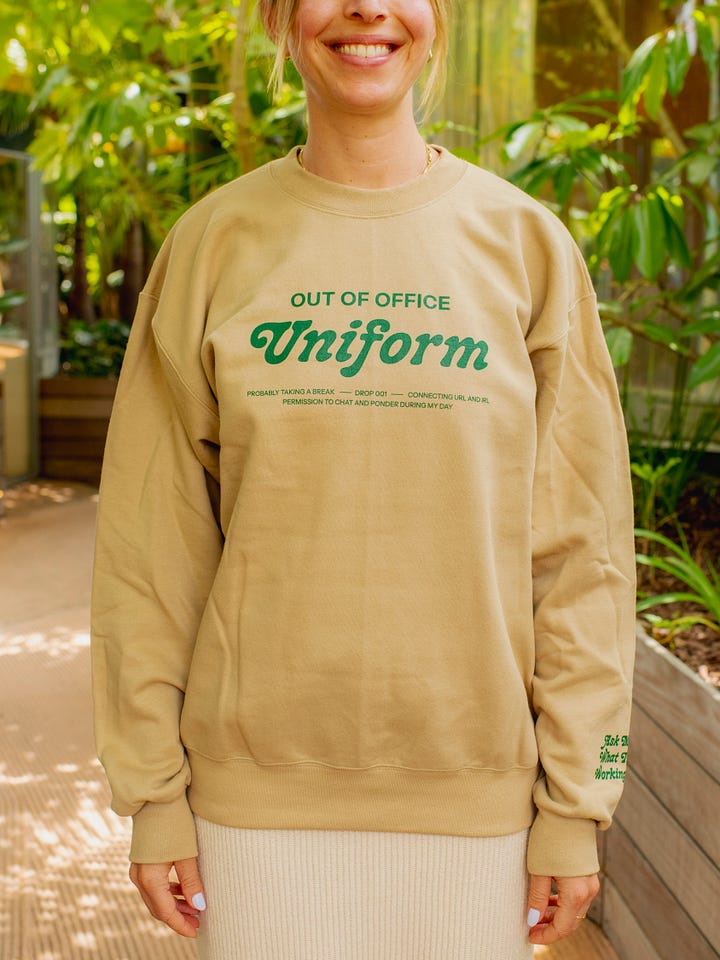
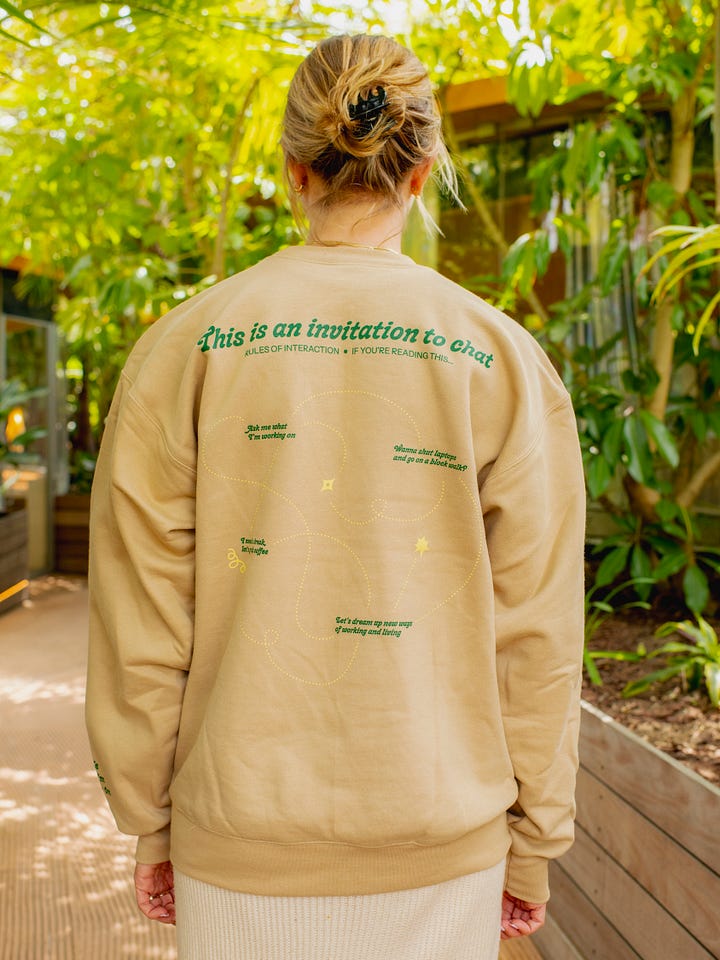
“What would it feel like to wear a uniform to be a part of a club of modern workers and connectors reimagine how we work and live in a modern world? To be seen as a connector in the wild fostering relationship building and furthering the idea of third places over office spaces?”
Sarah Jutras shared her experience being part of our first cohort.
Uniforms are the OG tools of work, and what we wear closest to our bodies. So close, that we often forget to think about them as tools.
But what’s also special about uniforms (or brand merch or university swag…) is that they help us find each other and create a sense of belonging.
The Out of Office Uniform is a tool for increasing your surface area of serendipity, connection, and intention. Equipping those wearing it and working from a cafe, coworking space or other communal third space (a place beyond the home (1st space) or office (2nd space), to be connectors of this new modern group of humans.
How it works
Order your uniform! Once a first cohort of 30 people has ordered their uniform, it will be produced and sent to you (arrival: 2-3 weeks from production date)
Put it on and venture out to a cafe, coworking or other third space to co-work wearing your uniform.
If two or more people wearing their OOO uniform meet up in a café, park, or co-working space, they unlock a pool of funds to buy each other coffee or a treat. By buying this uniform, you essentially pre-buy a coffee chat or coworking meetup ahead of time, and all that’s left is to actually wear your uniform and say hello!
If someone strikes up a conversation with you while wearing your uniform, surprise them by buying them a coffee using your OOO funds sent to you via a prepaid card for having started a conversation!
Not just merch.
Co-designed with our global community, this uniform is our first drop and tool for modern workers. But it’s not just merch: By buying this uniform, we are prototyping a community of practice (and an economy) that better serves us, as humans and humans who work.
It means you're part of a group developing new ideas, tools and ventures to pave the way to new models of living and working and get access and discounts to a directory of curated third spaces where work, people, ideas, art + culture collide.
We’re curious about this approach to connection and membership being built on network mechanisms that share genuine and meaningful value for this group of people.
For the release of our first batch, we’re excited to team up with
and in the coming months, see our Uniforms out in the field, and build a group of local connectors fostering relationship building and furthering the idea of third places over office spaces!Join us and order your uniform today!
This uniform is a collaboration between Out of Office Network x Chaotic Goods a research and design collective building tools to navigate the emotional ergonomics of cyberphysical spaces—what are the new feelings we experience from the internet? It has been created across many timezones and hours on Zoom + an in-person gathering in LA earlier this year 🌞

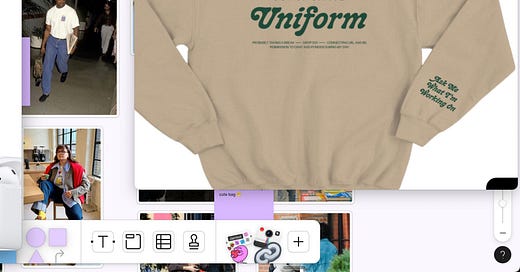




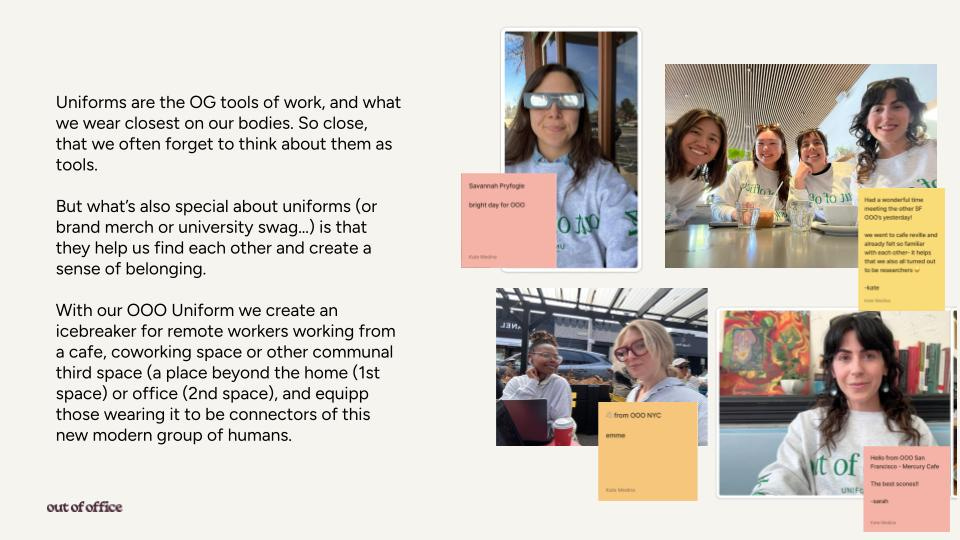
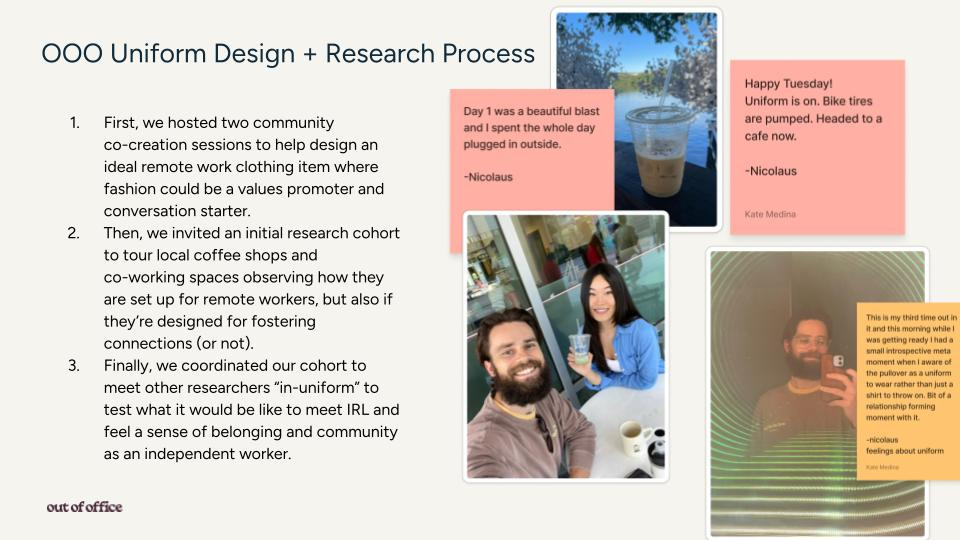

this is really really cool, Alice!
Yesss love this Alice! ✨👊